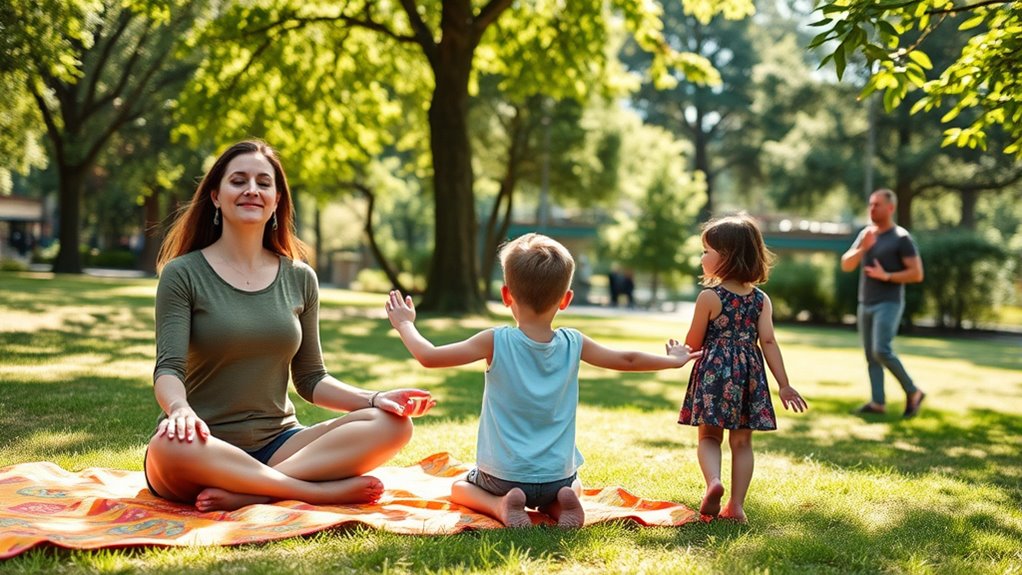You can easily practice mindfulness anywhere by using simple techniques like mindful breathing or engaging your senses. Try taking a few deep breaths to center yourself during breaks or observe your surroundings to heighten awareness. Mindful eating transforms mealtimes into enjoyable rituals, while mindful listening strengthens connections in conversations. Creating a calming environment can support your practice too. If you’re curious about more ways to bring mindfulness into your daily routine, there’s plenty more to explore.
Key Takeaways
- Practice mindful breathing by taking deep breaths in any setting to center yourself and reduce stress.
- Engage in the Five Senses Exercise by noticing what you can see, hear, smell, touch, and taste around you.
- Utilize the STOP Method: pause, breathe, observe your thoughts and feelings, then proceed with renewed clarity.
- Transform meals into mindful rituals by savoring each bite and eating without distractions to enhance enjoyment.
- Incorporate mindfulness into daily activities like driving or gardening by focusing on the experience and your surroundings.
Understanding Mindfulness

Mindfulness is more than just a buzzword; it’s a powerful practice that helps you stay anchored in the present moment. By focusing your attention on what’s happening right now, you cultivate awareness and engage with your surroundings. This practice can help you protect your energy during chaotic times, allowing you to maintain emotional health and stability. Additionally, adopting mindfulness can enhance your ability to cope with the challenges of aging, as it encourages supportive communication with loved ones. Engaging in mindfulness techniques can also improve your emotional resilience, enabling you to navigate life’s challenges more effectively.
This practice encourages you to observe your thoughts and feelings without judgment, fostering acceptance. Instead of getting lost in past regrets or future worries, you learn to appreciate the here and now.
Mindfulness can be seamlessly integrated into your daily routine, making it accessible even with a busy schedule. Whether you’re sipping coffee or walking, bringing mindfulness into these moments enhances your overall well-being, allowing you to connect deeply with yourself and the world around you. Engaging in music therapy can further enrich this mindfulness practice by promoting relaxation and emotional well-being.
Benefits of Practicing Mindfulness

When you embrace mindfulness, you’ll discover a wealth of benefits that can transform your daily life. Practicing mindfulness reduces stress and anxiety, enhancing your emotional regulation and mental clarity. Additionally, mindfulness is closely related to personal development as it fosters self-awareness and promotes continuous learning.
You’ll notice improved attention and decreased job burnout, leading to greater productivity and satisfaction at work. Additionally, mindfulness techniques, such as a body scan, can lower blood pressure and improve diabetes control, contributing to better physical health. Engaging in these practices can also support effective relaxation techniques, which are essential for managing stress. Studies show that incorporating low light office plants into your workspace can further enhance your ability to practice mindfulness by creating a calming environment.
Fostering resilience and a positive mindset is associated with higher happiness and success rates in various life areas. Research supports that regular meditation can enhance mental health outcomes, further emphasizing the importance of integrating mindfulness into your routine.
You’ll also cultivate deeper connections with others through enhanced empathy and mindful listening, allowing you to better understand and accept thoughts and feelings. The benefits of mindfulness truly extend into every aspect of life.
Quick Mindfulness Exercises for Any Setting

You can easily incorporate mindfulness into your day with simple exercises wherever you are. Try practicing mindful breathing during breaks or while waiting in line to center yourself. Mindfulness practices can significantly help individuals with emotional dysregulation, such as those experiencing symptoms of Borderline Personality Disorder. Additionally, the Five Senses Exercise helps you connect with your surroundings by noticing what you can see, hear, smell, taste, and touch. Practicing mindfulness can also enhance emotional intelligence, which reflects adaptability and team management. Engaging in these exercises can promote emotional healing, making it easier to cope with life’s challenges. Moreover, these practices can be particularly beneficial for those navigating relationships with a borderline narcissist, as they foster greater emotional stability.
Breathing Techniques Anywhere
Breathing techniques offer a simple yet powerful way to practice mindfulness anywhere, anytime. You can use deep breathing or box breathing to calm your nervous system, even in the midst of chaos. By focusing on the natural rhythm of your breath, you enhance present-moment awareness and reduce stress. Try the 3-Step Mindfulness Exercise: take a moment to breathe deeply, pay attention to your current thoughts, and observe any physical sensations without judgment. Just a few minutes of mindful breathing can decrease anxiety levels and promote calmness. Incorporating these techniques into daily activities, like waiting in line or sitting in traffic, helps you maintain emotional balance and enhances your overall wellbeing. Additionally, practicing mindfulness can improve your ability to manage stress effectively, leading to a more resilient mindset. Engaging in curiosity and happiness through mindful breathing can also lead to greater life satisfaction and emotional well-being. Moreover, adopting mindfulness can align with the sustainable fashion movement, encouraging a more thoughtful approach to consumption and lifestyle choices. Regular mindfulness practices contribute to preventive care and can significantly enhance overall health by reducing the risk of stress-related ailments.
Five Senses Awareness
Engaging your senses can be a powerful way to anchor yourself in the present moment, making the Five Senses Awareness exercise an effective mindfulness tool for any setting.
To practice mindfulness, pause and take a deep breath. Focus on what you can see, hear, touch, taste, and smell around you. Spend a moment on each sense, allowing your awareness to deepen. Incorporating elements from spiritual retreats can further enhance your mindfulness practice. This exercise aligns with the principles of the Law of Attraction, promoting a positive mindset that attracts better experiences. Regular practice of mindfulness techniques can also enhance productivity and overall well-being.
This quick exercise helps reduce stress and anxiety by shifting your focus away from negative thoughts and promoting appreciation for the here and now. Interestingly, just as fresh orange juice can enhance your mood, incorporating the Five Senses Awareness into daily routines can transform ordinary moments into opportunities for mindfulness, enhancing your well-being and emotional regulation.
Whether you’re at work, home, or outdoors, incorporating the Five Senses Awareness into daily routines can transform ordinary moments into opportunities for mindfulness, enhancing your well-being and emotional regulation.
Mindful Breathing Techniques

How can simple mindful breathing techniques transform your daily routine? By incorporating mindful breathing into your life, you can anchor your awareness in the present moment and reduce stress.
Try techniques like box breathing: inhale for four counts, hold for four, exhale for four, and pause for four. This method calms your nervous system and alleviates anxiety. Engaging in mindful practices can significantly enhance your overall mental health.
Alternatively, practice gentle abdominal breathing, focusing on expanding your diaphragm, which promotes relaxation and enhances oxygen flow. Engaging in these exercises for just a few minutes daily can improve emotional regulation and focus. You can even incorporate breath awareness during commutes or while waiting in line, turning mundane moments into opportunities to practice mindfulness and enhance your overall well-being. Additionally, practicing mindful breathing can help alleviate back pain, which is important for overall comfort and well-being.
Engaging Your Senses in Daily Life

Engaging your senses can transform everyday experiences into moments of mindfulness.
When you savor each bite of your meal or immerse yourself in the sights and sounds of nature, you deepen your connection to the present moment.
Let’s explore how mindful eating and nature connection can enhance your daily life.
Savoring Food Experiences
Savoring food experiences can transform your daily meals into mindful rituals that enhance enjoyment and presence.
By engaging all five senses—sight, smell, taste, touch, and sound—you encourage mindfulness meditation during meals. Mindful eating invites you to slow down and appreciate the flavors and textures, leading to greater satisfaction and reducing the urge to overeat.
Eating in silence or with minimal distractions deepens your connection to food, fostering gratitude and enriching your overall experience. Focus on the cooking sounds or the physical sensations of each bite.
These simple exercises can cultivate awareness and presence, positively impacting your mental well-being by reducing stress and promoting a balanced relationship with food.
Enjoy every bite!
Nature Connection Activities
When you immerse yourself in nature, you open the door to a world of sensory experiences that can elevate your mindfulness practice.
Engaging in nature connection activities boosts your present-moment awareness and helps reduce stress.
Here are a few ways to connect with nature mindfully:
- Mindful walking: Take a stroll in a park, listening to the sounds around you.
- Mindful gardening: Feel the soil and observe plant growth, grounding yourself in the process.
- Mindful eating outdoors: Savor the flavors of your meal while surrounded by natural beauty.
The STOP Method for Stressful Moments

Stressful moments can feel overwhelming, but the STOP method offers a practical way to regain your composure. This mindfulness technique consists of four simple steps:
| Step | Action | Purpose |
|---|---|---|
| Stop | Pause your activity | Create stillness |
| Breathe | Take a deep breath | Center and relax |
| Observe | Assess your feelings | Identify thoughts and tension |
| Proceed | Return to the task | Engage with renewed clarity |
Incorporating Mindfulness Into Routine Activities

Incorporating mindfulness into your daily routine can transform ordinary activities into moments of clarity and presence. By paying attention to the sensations in your body and the world around you, you can enhance your experience of simple tasks.
Incorporating mindfulness into daily life turns routine activities into opportunities for clarity and a deeper connection to the present moment.
Here are a few ways to practice mindfulness:
- Mindful eating: Savor each bite, listen to cooking sounds, and eliminate distractions to deepen your appreciation for food.
- Mindful driving: Focus on the steering wheel and road, while observing your surroundings, to boost awareness and safety.
- Mindful gardening: Connect with nature by noticing soil textures and environmental sounds during planting and nurturing.
Engaging in these practices helps clear mental clutter and fosters a deeper presence in your activities.
Mindful Listening in Conversations

Mindful listening transforms conversations into meaningful exchanges, as it requires you to fully engage with the speaker. By practicing mindfulness, you set aside distractions and judgments, allowing the speaker’s words, tone, and body language to resonate with you. This approach fosters empathy and connection, enhancing your understanding of others.
To practice mindful listening, identify your personal stressors and consciously put them aside. Share your experiences without interruption, and reflect on your feelings and thoughts afterward.
Engaging in this mindfulness activity can improve relationships, building trust and camaraderie. Regularly practicing mindful listening not only enhances communication but also helps reduce anxiety disorders and promotes better emotional regulation, contributing to your overall mental well-being.
Creating a Mindful Environment

Creating a mindful environment is essential for enhancing your practice of mindful listening and other mindfulness techniques. To truly support your meditation and mindfulness-based stress reduction efforts, consider these tips:
- Minimize distractions: Turn off electronic devices and clear clutter to foster calmness and focus.
- Incorporate natural elements: Add plants and guarantee ample natural light to reduce stress and promote well-being.
- Personalize your space: Use calming colors, soft fabrics, and meaningful objects that evoke positivity and gratitude.
Designate a specific area for your mindfulness activities, guaranteeing it’s comfortable and quiet.
This dedicated space will help you relax the body and reinforce your habit of regular practice, making it easier to engage deeply in your mindfulness journey.
Resources for Continuous Mindfulness Practice

While you may have established a mindful environment, having access to a variety of resources can greatly enhance your continuous mindfulness practice.
Consider exploring the Positive Psychology Toolkit© for structured exercises and worksheets that support your journey. Numerous apps and online platforms offer guided meditations and simple mindfulness exercises, making it easy to practice whenever you can.
Joining local mindfulness groups or workshops fosters connection and shared experiences, enriching your practice. You can also investigate literature on mindfulness; books and articles provide valuable insights and techniques.
Finally, online platforms often host webinars and courses led by experts, allowing you to deepen your understanding of meditation and mindfulness while integrating these practices into your daily life.
Frequently Asked Questions
How Can I Practice Mindfulness Anywhere?
You can practice mindfulness anywhere by focusing on your breath. Take deep inhales and exhales to ground yourself in the present moment.
Pay attention to your surroundings; notice the sights, sounds, and smells. Try mindful walking by feeling each step and the ground beneath your feet.
When overwhelmed, use the STOP technique: Stop, take a breath, observe your thoughts, and proceed with renewed awareness.
Simple exercises can help you stay connected to the moment, too.
How to Practice Mindfulness in Public?
To practice mindfulness in public, start by taking deep, intentional breaths to center yourself.
Engage your senses; notice the sights, sounds, and smells around you.
When waiting in line or during transit, use the STOP technique—pause, breathe, and observe without judgment.
As you walk, pay attention to each step and the sensations in your body.
These simple actions help you stay grounded and enhance your connection to the present moment.
What Are 5 Ways That You Can Practice Mindfulness?
You mightn’t realize how easy it’s to practice mindfulness in your daily life! Start with mindful breathing—take deep breaths to ground yourself.
Next, engage your senses by noticing the world around you. Try walking meditation, focusing on each step as you go.
Transform meals into mindful eating experiences, savoring every bite.
Finally, use the STOP technique when you feel overwhelmed: pause, breathe, and observe your thoughts before moving forward.
How Do You Practice Mindfulness Outside?
To practice mindfulness outside, start by focusing on your breath, feeling the air fill your lungs while you observe the sounds of nature around you.
Engage your senses by noticing the colors, smells, and textures of your environment.
When walking, pay attention to each step and the ground beneath your feet.
You can also immerse yourself in activities like gardening or walking your dog, appreciating every detail of the experience.
Conclusion
By weaving mindfulness into your daily life, you can find peace and clarity no matter where you are. Remember, it’s not about moving mountains but taking small steps to be present. Whether you’re at work, home, or on the go, these practices can help you stay grounded. So, take a deep breath and embrace the moment—you’ll be surprised at how much richer life can be when you focus on the here and now.









